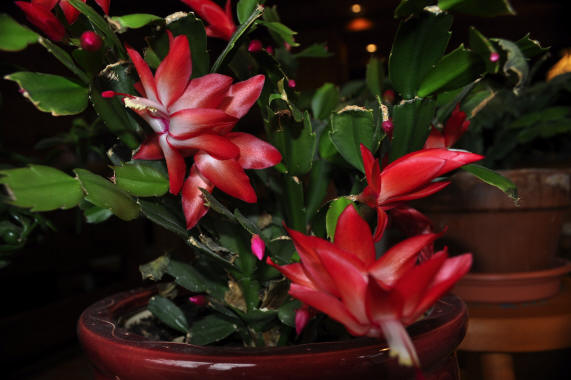
Act Now to Get Two Favorite Holiday Plants to Flower Again.
Seeing the trees turn colors and falling leaves reminds me it is time to move my poinsettia inside to trigger it to re-bloom in time for the holidays. Getting an all-green poinsettia to turn red is not difficult, it just takes some effort and discipline.
The traditionally red leaves of a poinsettia are called bracts. Their flowers actually are the small yellow blooms seen at the center of the red bracts. To develop the red bracts in December, poinsettias need very specific amounts of light and dark at the proper time. They require 14 hours of total darkness out of a 24-hour day. Usually around the first of October is
the time to start a program that controls the amount of light the poinsettia receives in a 24-hour period.
To accomplish this, around 6 pm, place the poinsettia in a closet or room such as the basement that receives no interior light from any lamp or outside light such as a street lamp. It must remain in the dark for a full 14 hours. If a closet or room is not practical, place a big box over the plant. At 8 am each morning, remove it from the dark and place it so it gets
sunlight. A southern window is a good spot. At 6 pm, return the poinsettia to its dark "sleeping" spot. Keep up this program and usually in early December the red bracts start to appear. I have had good luck placing my poinsettia in the basement under a 48" florescent shop light, placed close to the plant, set on a timer to give it the required dark time. This is much
easier than having to remember to move the plant.
Once the red bracts develop fairly well, the poinsettia is ready for holiday display and the red bracts should remain and the tiny yellow flowers appear. A red poinsettia usually will remain red until spring. Once spring comes, it can be cut back to about 8-10" (depending on its size), repotted, and left outside with periodic fertilization and pinching back until the
fall triggers putting it through another cycle of controlled darkness.
My favorite holiday plant is the Christmas cactus. Like the poinsettia, these plants are short-day plants, meaning they flower in response to shorter days. However in this case, flowering also is related to nighttime temperatures. Ideal temperature range for flower bud development is between 55 and 60 degrees for a period of six weeks. As long as the temperatures
remain in this range, plants will develop buds regardless of daylight hours. To achieve short-daylight induced blooming, place plants in a room that does not have lamplight before sunrise or after sunset so they receive no more than 8-11 hours of light or under timed light as above.

During flower bud formation, stop fertilizing and only water enough to keep the leaves from becoming shriveled. Sometimes my plants reward me with a few more blooms again in March or April. My personal observation is that keeping them on the dry side after flowering is a sort of rest period that, when followed by fertilization, invigorates them into blooming again.
One of the most frustrating things that can happen to Christmas Cactus is after the flower buds develop they drop off the plant. Several different conditions, usually over-watering, insufficient light, or relocating the plant during early bud development can cause bud drop. Years ago I discovered that moving a plant led to the buds "turning" toward the light source and
then falling off! Now I leave them alone until the buds are well developed, nearly in bloom, before I relocate them for viewing enjoyment.
Both of these holiday plants, so common and yet so beautiful, are easy to grow and
Read other articles on house plants
Read other winter related gardening articles
Read other articles by Connie Holland